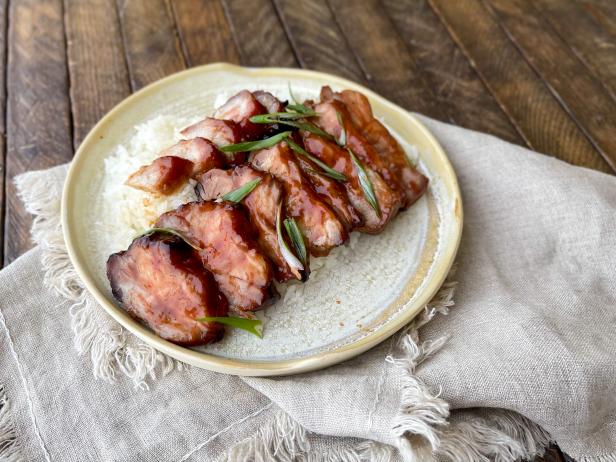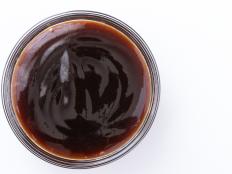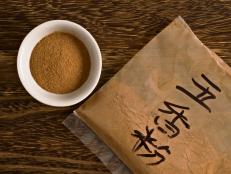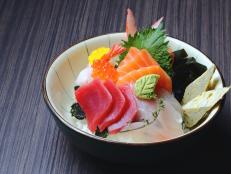What Is Oyster Sauce?
The viscous sauce brings so much flavor to whatever it touches — from stir fries to sauteed vegetables to marinades.

Michelle Lee Photography/Getty Images
By Margaret Wong for Food Network Kitchen
Margaret is an editor at Food Network.
Gently salty and briny, with a velvety smooth, thick texture, oyster sauce is in a number of Asian dishes. The condiment brings rich, savory flavor to whatever you pour it over or into – from Chinese broccoli to stir-fry marinades – and it’s a mainstay in many Asian and Asian American kitchens. Whether you’re tasting it for the first time, or learning the breadth of its versatility, here are the basics of this staple sauce.
What Is Oyster Sauce?
Oyster sauce is a thick, savory condiment common in Chinese, Vietnamese, Thai, Malay and Khmer cuisine that’s made by cooking oysters. Traditionally, oysters are slowly simmered in water until the liquid caramelizes into a viscous, dark black-brown sauce. But to speed up the process, some commercialized versions are instead made with oyster extracts, plus salt, sugar, corn starch and caramel coloring.
According to one of the most famous makers of oyster sauce Lee Kum Kee, the condiment was accidentally invented in the Guangdong province of China by its founder, Lee Kum Sheung, when he overcooked oyster soup. In 1888, he created Lee Kum Kee to sell the sauce; the company is thriving to this day – and is our go-to brand for the sauce.
What Does Oyster Sauce Taste Like?
Umami-rich oyster sauce tastes salty (thanks to the brininess of the oysters) with a hint of sweetness. It doesn’t taste fishy.

How to Use Oyster Sauce
Oyster sauce can be had as is, straight from the bottle without any further cooking. Use it as a dressing or dipping sauce – either on its own or mixed in. Since the sauce is on the thicker sauce, avoid using it as is over more delicate greens or ingredients. Instead, opt to thin it out with other ingredients such as soy sauce or mirin, or pair it with hardier vegetables.
Try it as a dressing on sauteed gai lan (Chinese broccoli) and Hong Kong-style lo mein. For dipping, it’s traditionally paired with dim sum staple low bak go (turnip cake). Mix it into peanut dipping sauce for refreshing Spring Rolls, or as a condiment when having hot pot.
Oyster sauce can also be used as a meat marinade. Try it in Cantonese-style Mapo Tofu, Char Siu (pictured above) and Claypot Rice.
Oyster sauce is common in stir fries, as part of sauce mixtures that ultimately bring all the ingredients together. Try it in Singapore Mei Fun, Crispy Pan-Fried Noodles, Drunken Noodles, Beef and Broccoli and more.
Oyster sauce can be used to braise and stew. The condiment is traditionally used to braise Abalone and Shiitake Mushrooms in this Lunar New Year dish.
Finally, oyster sauce can be used in soups. Try it in Mala Tang.
How to Store Oyster Sauce
Unopened bottles of oyster sauce are shelf stable and should be stored in a cool, dry place such as the pantry. Avoid keeping it near heat sources like the dishwasher or stove. Once opened, keep bottles of oyster sauce in the refrigerator.
Avoid freezing oyster sauce, especially in its original glass bottle. The bottle can crack, and freezing the sauce will change its viscosity.

Bowonpat Sakaew/Getty Images
Ingredients In Oyster Sauce
Oyster sauce is made of oyster extract, sugar, water, salt and thickened with corn starch.
Substitutes for Oyster Sauce
- Vegetarian oyster sauce: If you’re avoiding certain animal products, you can use vegetarian oyster sauce or vegan oyster sauce. Shiitake mushrooms pack these alternatives with umami, in place of the oysters.
- Soy sauce or tamari: Soy sauce is a decent alternative for oyster sauce as well, but it’s much saltier and thinner. Add sugar or sweetener to taste and thicken it with cornstarch by slowly whisking it in until the mixture is the same consistency as oyster sauce. Tamari is slightly less salty than light (“regular”) soy sauce, but treat it the same way and add sugar and thicken it with cornstarch.
- Hoisin sauce: Hoisin sauce has a similar consistency as oyster sauce, but is primarily sweet. Add salt, and mushroom broth to taste give it more umami.
- Mushroom broth: Taking a page from its vegetarian and vegan alternatives, mushroom broth can also work as a substitute. We recommend using dried shiitake mushrooms. Pour boiled water over the dried mushrooms in a heat-safe bowl and cover the bowl loosely with a lid or plate for 30 minutes. Then, squeeze out the water from the mushrooms into the water used to rehydrate them (it will all be brown). Add salt and sugar to taste; thicken the sauce with corn starch.
Buy Oyster Sauce Substitutes
Related Links:

































































